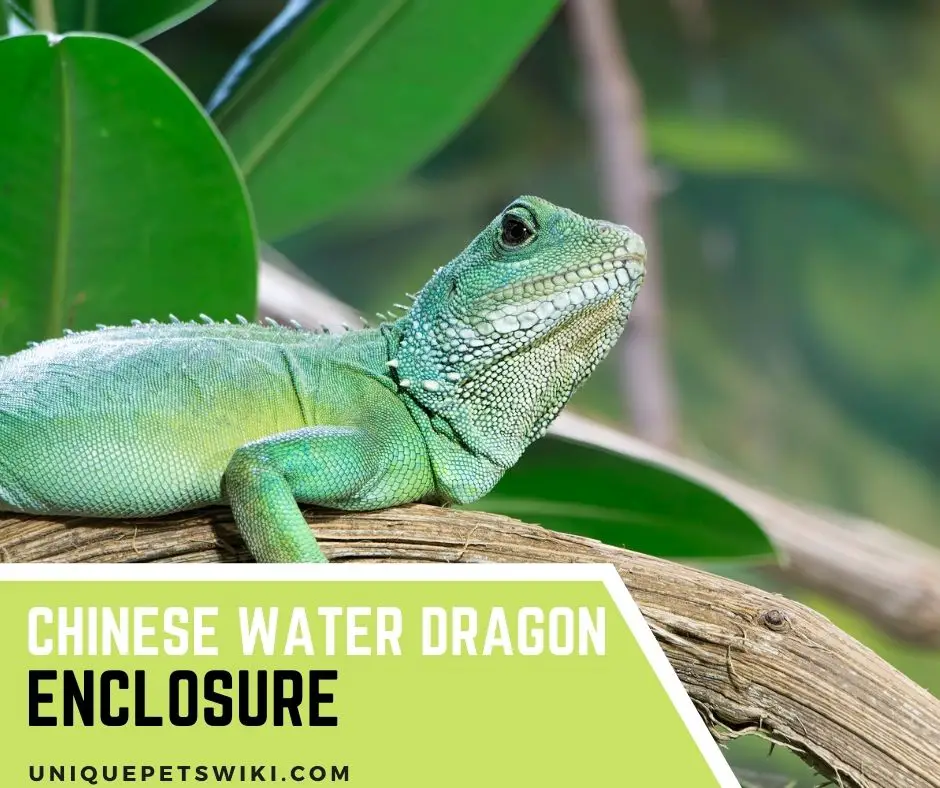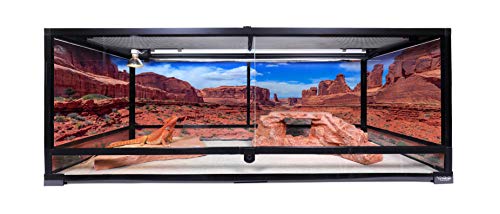Do you have a Chinese Water Dragon as a pet and are looking for a tank for them? Or maybe you’re looking for a guide to help you set up your pet’s tank?
In this article, we will show you everything you need to know, from setting up your pet’s tank to your pet’s everyday needs.
Contents
Why Do Chinese Water Dragons Need To Be Enclosed?
Most Chinese Water Dragons like being solo, and they have specific sets of needs compared to some reptiles. They spend most of their time in the wild basking on branches and rocks near bodies of freshwater and streams.
Chinese Water Dragons are well-known exotic species found in China and mainland Southeast Asia. They are reptiles with scales that range from dark green to bright green and long pointy tails, which can reach a total length of 1 m or 3.3 ft, including the tail, and live for 10 to 15 years.
The tail, which accounts for somewhat more than two-thirds of the total body length, may be utilized as a weapon for balance and aid in swimming.
The pineal eye, sometimes known popularly as the third eye, is a tiny, iridescent, photosensitive area between the eyes of the Chinese water dragon.
Considered to help thermoregulate their bodies by perceiving variations in light, allowing them to bask and seek refuge after sunset. These animals are pretty docile and tolerate strenuous activities.
That is why when making a cage for your Chinese Water Dragon, it is better to put something they are familiar with. When they adjust to their new environment, a pond or tree branches, Chinese Water Dragons tend to hide, especially underwater.
Chinese Water Dragon Enclosure: A Detailed Set-up Guide
The minimum tank size for a single dragon should at least be 75 gallons; consider a bigger tank. Whether you plan to keep more than one dragon, make sure your cage is at least 4 feet (1.22 m) long and 5-6 feet tall.
To begin with, it is usually preferable to a larger cage rather than upgrading as your pet develops. Here is a step-by-step guide for you to build and design your Chinese Water Dragons Tank.
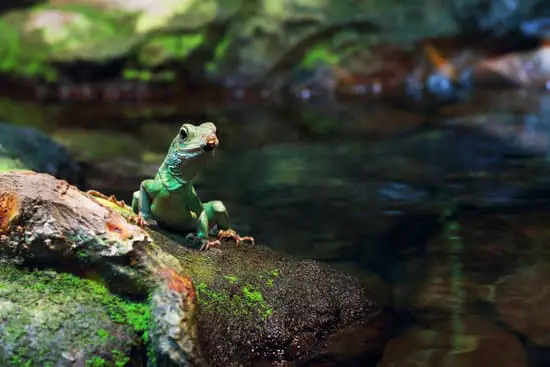
Step 1: Place them in your desired place. To ensure safety, install the tank in a stable location.
Step 2: Add your bedding. Chinese Water Dragons demand high humidity levels of 70-80 percent. Moisture-retaining bedding is required to help maintain humidity.
Retain your baby dragon on a non-loose substrate until they reach 8 inches (20 cm) from head to tail and 8 inches (20 cm) from head to tail.
Step 3: Setup the lighting and heater for your Chinese Water Dragon. The lighting arrangement for your Chinese water dragon is critical. Ensure that UVB is installed at ideal distances to get the best result.
Chinese water dragons would also like to simply avoid UVB exposure, providing shaded places and a hiding spot. Please see the UVB section below for different distances.
Step 4: Add your decorations. Babies and teenagers, in particular, require more accessories and plants to feel safe. Plants and branches will aid in climbing and sunbathing and prevent nose rubbing.
Hiding areas will help you conceal UVB and light while making you feel safer. Ceramic or slate tiles and other basking platforms will retain heat and comfortable the dragon.
Step 5: Choose the right plants for your Chinese Water Dragon. Keeping living plants is more complex than purchasing artificial ones. You will need to utilize soil devoid of fertilizer as it is harmful.
Because of the excessive humidity, it is accessible to over-water plants. Stray bugs can also deposit eggs in the ground. Instead, use fake plants that are less likely to be destroyed.
Several Types Of Enclosure
Reptile enclosures have several types that are commonly used by reptile owners, mainly:
Rack
Racks are vertical shelving systems designed to store as many animals as possible in as little space. They are usually outfitted with heating devices such as heat tape and thermostats, and they also use snug-fitting tubs to make escape-proof cages.
Disposable substrates like butcher paper or paper towels, food and water dishes, and a plastic hide box are standard enclosures.
The Rack And Tub system is ideal for breeders that need to retain dozens, hundreds, or even thousands of breeding Chinese water dragons. Racks are also utilized by pet owners and collectors searching for a low-cost, space-saving way to preserve their reptiles.
Pros:
- Setup is affordable.
- escape-resistant
- keeps moisture well
- that can be accommodated in a single room
- leverages vertical space, reducing the footprint of the setup
- increases the number of reptiles
- The inexpensive heat
- watertight
- simple to clean and maintain
Cons
- A lack of space restricts the possibility of creating a stimulating atmosphere.
- Hundreds of Chinese water dragons may perish if the thermostat fails.
- ventilation problems
- The size of the available tubs restricts the enclosure size.
- A lack of ventilation and space severely constrains the temperature gradient.
- not designed to accommodate UVB or any other sort of supplemental illumination
Tubs
Tubs are transparent or opaque plastic storage tubs that have been heated with a heating pad and had ventilation holes punched into them with a soldering iron and reused in Chinese water dragon homes. Standalone tubs can have 54L × 22W x 15H or a volume of 65 gallons.
Tubs are commonly used as a cost-cutting technique when the keeper does not have enough money to build a complete enclosure. When utilizing plastic tubs to hold a Chinese water dragon, volatile organic compounds (VOCs) are a particular problem.
VOCs may suppress a its immune system, causing disease and shortening its lifetime in captive Chinese water dragons.
Pros
- affordable
- portable
- maintains heat and humidity effectively
- opaque or near-opaque walls
- fairly escape-proof
- easy to clean and maintain
- watertight
- readily available
Cons
- may produce VOCs
- limited viewing
- UVB lighting can be difficult
- the only heating option is a heating pad or heat tape
- The size of the tub limits the amount of free area available.
- not very appealing
- There is very little ventilation.
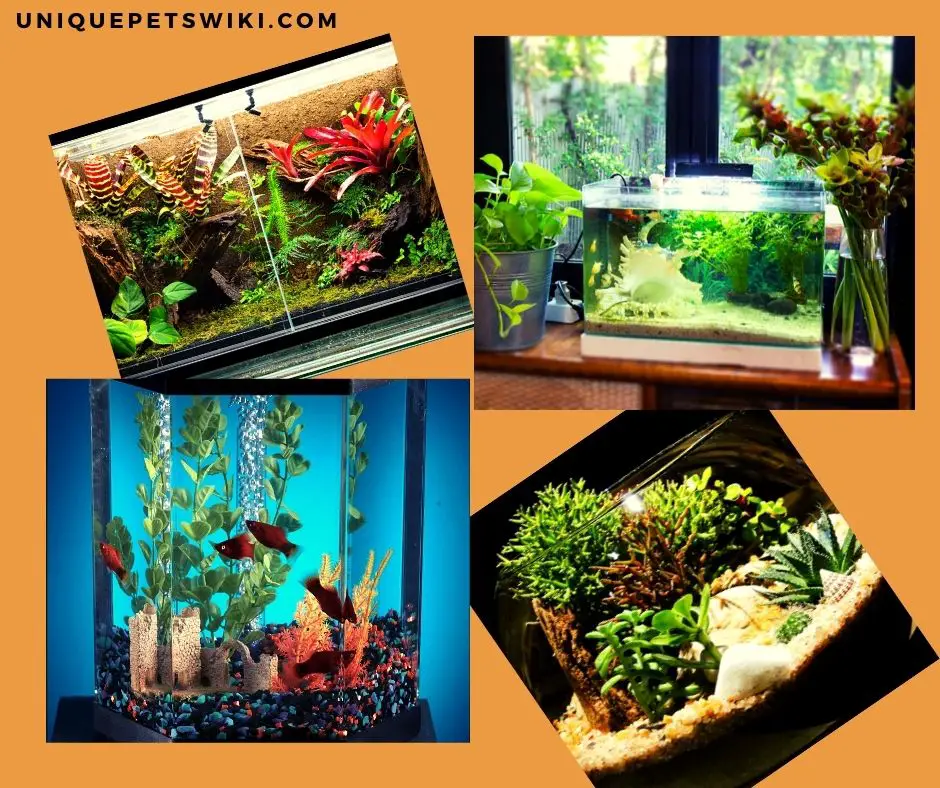
Aquariums
Aquariums are top-opening glass containers typically used to hold pet fish, but they may also house Chinese water dragons. An aquarium is suitable for keeping tiny Chinese water dragons because it is one of the few big and impervious enclosures to accommodate their primarily marine existence.
Pros
- easy to clean
- easy viewing
- well ventilated
- make overhead heating and lighting easier
- fairly appealing
- watertight
- allow for a diversified temperature gradient in a limited space
- easily accessible
Cons
- massive
- susceptible to escapes
- Transparent walls can cause anxiety in the occupier.
- If injured, it shatters into sharp fragments
- are frequently available in quantities of up to 75 gallons
- Without alteration, it does not retain heat or humidity effectively.
- only accessible from the top, which may make people defensive
Terrariums
Terrariums are enclosures with a front entrance designed exclusively for reptiles. They are available in several materials, notably glass, wood, or PVC, and customized to practically any size or form. Terrariums can have sliding or swinging acrylic or glass doors.
Glass Pros
- easy to clean
- easy viewing
- highly escape-resistant
- allow for a varied temperature gradient in a very compact space
- Front-facing doors facilitate access.
- appealing
- somewhat waterproof
- properly ventilated
Cons
- Big
- Without alteration, it does not retain heat or humidity effectively.
- unable to stack
- If injured, it shatters into sharp fragments
- Transparent walls can cause anxiety in the occupier.
- costly
Wood Pros
- Affordable
- Front-facing doors make it simple to get entrance.
- maintains heat and humidity somewhat well
- simple to personalize
- may be made to almost any size
- Lightweight
- allows for overhead heating and lighting
- They can’t break free
- can be made stackable
Cons
- may not be adequately ventilated
- In standing water or excessive humidity, materials may begin to rot.
- may hold too much heat, causing the thermal gradient to be hampered
- Volatile
- The beauty of wood varies based on the design and type of wood used.
PVC Pros
- Portable
- They can’t break free
- available in a broad range of sizes
- facilitates overhead heating and lighting
- generally stackable
- front-facing doors enable easy access
- Sturdy
- simple to personalize
- resists moisture and leaks well
- retains heat and water very well
- easy to clean and maintain
Cons
- Higher-end enclosures might be costly.
- can retain heat excessively well, worsening the thermal gradient
- often inadequately ventilated
- If not put on a level surface, it may lose its form.
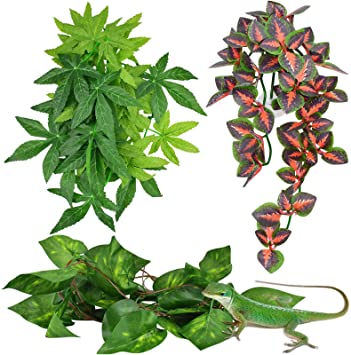
Grow Tents
Raise tents also grow plants indoors; however, some Chinese water dragon enthusiasts reuse them as their cages. With the proper modifications, grow tents may build affordable and spacious enclosures for small, medium, and large-sized Chinese water dragons.
Pros
- inexpensive
- retains heat and humidity well
- opaque walls
- portable
- It may be altered to allow for overhead heating and UVB
Cons
- unattractive
- limited ventilation and viewing
- not escape-proof
- can be leaky
- susceptible to overheating
- not very durable
- The reflective inner lining may be harmful to reptile eyes
Screen Cages
Screen cages are vertically oriented reptile enclosures designed to fulfill the unique demands of Chinese water dragons with mesh walls that emphasize height.
Pros
- inexpensive
- easy access from the front
- facilitates overhead heating and lighting
- extremely lightweight
- very well ventilated
- escape-resistant
Cons
- leaky
- Sizes are only accessible in a restricted number of commercially available sizes.
- inability to hold heat or humidity
- somewhat obstructs viewing
- can be challenging to disinfect
Tortoise Tables
The tortoise table is an enclosure with low walls and no roof that is usually elevated off the floor on legs, much like a dining table and can also be utilized for Chinese water dragons.
Pros
- inexpensive
- high levels of ventilation
- a lot of open floor area
- simple access
- Opaque walls
- allows for overhead heating and lighting
Cons
- In general, it is not commercially available in the United States.
- can be challenging to disinfect
- In standing water or excessive humidity, materials may begin to rot.
- does not efficiently keep heat or moisture
- Wood is a combustible material.
- The beauty of wood varies based on the design and type of wood used.
Furniture Conversions
Furniture conversions are cages made from human furniture such as entertainment centers, bookcases, and coffee tables. Opaque walls A furniture makeover is most suited for tiny to medium-sized Chinese water dragons. It is usually a project best left to pretty handy individuals.
Pros
- very attractive
- customizable
- It can help you save money
Cons
- massive
- The furnishings restrict size.
- If not adequately sealed, it will decay in the presence of water
- access can be difficult
- limited ventilation
- can be challenging to disinfect
Enclosure For Baby Chinese Water Dragons
A baby Chinese water dragon can live up to 12 months old in a tank with a size of 55 gallon. Hence, the most suitable tank for these tiny ones is the Exo Terra Tank. This cage measures 36″x18″ x24″ and equals 67 gallons.
In the wild, your newborn Chinese water dragon would spend a lot of time in trees above ground; thus, it is essential to guarantee you can handle the size and demands of your new dragon. Your Chinese water dragon will surely exceed its surroundings; therefore, keeping it in a tank will not impede its growth.
Materials like plants and branches are necessary for your Chinese Water Dragons tank. Your goal here is to make a suitable environment for your dragon. Most reptile and amphibian habitat plants cost around $5 and not more than $40 because most sellers sell a bundle of habitat plants.
Check out these products for your dragon’s tank:
- REPTI ZOO Reptile Glass Terrarium
- KATUMO Reptile Plants, Amphibian Hanging Plants
- Kathson Reptile Habitat Decor
- Exo Terra Moss Ball, Water Clarity and Odor Control for Aqua-Terrariums
- Reptile Terrarium Decoration Set
- Claymmny 5-in-1 Reptile Terrarium Decoration Set
Last update on 2022-12-29 / Affiliate links / Images from Amazon Product Advertising API
Enclosure For Adult Chinese Water Dragons
An adult Chinese water dragon needs 55 gallons of space. This is the reason why terrariums are the most suitable tank for them.
Vivariums or Terrariums offer just enough room without feeling cramped especially during months when temperatures soar outside. Screen tops must always be provided so they cannot escape. These screened lids will also ensure that their environment isn’t too humid since this could lead towards illness due to humidity levels rising inside the home.
Check out these materials for your dragon’s tank:
- Carolina Custom Cages Terrarium
- AQUA KT Reptile Terrarium Forest Tree with Plant Leaves for Amphibian Habitat
- Kathson Reptile Plants Hanging Terrarium Plant
- Reptile Plants Hanging Fake Vines Artificial
Last update on 2022-12-29 / Affiliate links / Images from Amazon Product Advertising API
Basic Enclosure Configuration For Chinese Water Dragon
Substrate, visibility, illumination, accessibility, and safety are variables in determining the best location for your Chinese water dragon habitat.
Keep the cage available for cleaning, feeding, and maintenance at all times, and keep proper lighting and humidity levels in place. Ensure it’s in a secure location where youngsters or other pets can’t access it or run into it.
In the following, we will go into specific factors to establish an ideal enclosure for Chinese Water Dragon.
Substrate For Chinese Water Dragons
People who’ve already owned Chinese water dragons for a long time are probably familiar with the term “substrate.” Not only does the substrate you select affect the appearance of your water tank, but it also has a massive impact on the health of your creatures.
For those unfamiliar, a substrate is a substance used by pet owners to line the surface of an aquarium or terrarium.
Using the wrong substrate can endanger your Chinese Water Dragon’s life. Some materials used are orchid bark, newspaper, Astroturf with bonded or melted edges, mulch, bedsheets, or paper towels.
Some individuals even use sand to kill their pets, arguably the safest method. While chasing crickets, your dragon is exceptionally likely to consume part of the substrate, which can and will ultimately cause impaction.
Best And Worst Substrate Options
Best Substrates Options
- Topsoil
- Large orchid bark chips
- Coconut coir mixed with soil and topped with large bark chips
- Cypress mulch with topsoil
- Reptile carpet, non-adhesive shelf liner, or butcher paper for younger Chinese water dragons
Worst Substrate Options
- Paper towels
- Reptile carpet for adults
- Sand
- Moss
- Coniferous tree shavings or chips
- Gravel
- Alfalfa pellets
Instruct Owners To Setup Substrate
It is essential to know how much substrate we should put. A 650-gram substrate is required for a 40-gallon terrarium. This reconstituted coir extends to 8 liters. If you have anything enormous, a 5Kg coir bale expands to 65 gallons of coir.
With a thickness of about 2-inch because the substrate holds humidity well and is not dusty.
Layering various substrates allows you to use the advantages that each one offers. Layering different substrates will enable you to mist your plants manually; an automated mister, like the Exo Terra monsoon, is a good choice.
The Exo Terra reptile fountain emits bubbling water, which helps to increase humidity levels. The majority of dragons enjoy being in the water.
UVB light And Heat For Chinese Water Dragons
Chinese water dragons are active throughout the day and want artificial sunshine to remain calm at night, ensuring their habitat is well-ventilated.
A UVA/UVB bulb in the terrarium will provide natural light during the day, and a nighttime heater or heat lamp will keep them warm at night.
Ideal UVB Light And Heat For Chinese Water Dragons
When you put up the cage, you’ll want to have a warm and chilly side because the Chinese water dragon is a tropical species that prefers warmth and sunlight. Use a high-quality digital thermometer to check your dragon’s temperature levels reliably.
- Basking area – 90ºF to 100ºF
- Ambient and cool temperature – 75ºF and 80ºF
- Nighttime temperatures – above 75ºF
Most reptiles, including water dragons, require UVB light, an invisible wavelength that the sun naturally releases to assist reptiles with calcium metabolism.
Your water dragon may become sluggish, refuse to eat, and suffer metabolic bone disease if it lacks it. The two most prevalent UVB sources in the pet world are fluorescent bulbs and mercury vapor lamps.
Instruct Owners To Setup Light
You should set UVB bulbs six to eight inches away from where your water dragon may absorb the invisible rays. Also, avoid placing the bulb on a plastic, plexiglass, or glass surface. These compounds will prevent UV rays from reaching the areas where your reptile requires them.
Check out these UVB bulbs that might be perfect for your dragon’s tank:
Always check your dragon’s tank thermostat, maintaining the right temperature for your Chinese Water Dragon.
Humidity For Chinese Water Dragons
If you want to keep your Chinese water dragon happy and healthy, keep the humidity levels in the cage at an optimal level because these lizards are native to Southeast Asia’s tropical regions and require high humidity levels of over 80%. Poor humidity levels can cause shedding issues, such as trapped skin on the toes and tail.
Ideal Humidity For Chinese Water Dragons
Maintain an approximate humidity level of 80%. Assuming you live in an arid area, spraying the cage a few times each day should suffice. Always supply a large water dish filled with fresh water. Chinese Water dragons, according to experts, can hold their breath for up to 25 minutes at a time.
How To Create And Maintain Humidity In The Tank
In this case, a good humidity gauge might come in handy. Hand misters are enough but if you would like to use an automatic mister, the Exo Terra monsoon is recommended.
The Exo Terras reptile fountain emits bubbling water, which helps to increase humidity levels. The majority of dragons enjoy being in the water.
Accessories For Chinese Water Dragons
The important thing here is to make a comfortable tank for your Chinese water Dragon. That is why finding the right accessories for your tank is necessary.
Best Accessories
- REPTI ZOO Reptile Glass Terrarium
- KATUMO Reptile Plants, Amphibian Hanging Plants
- Kathson Reptile Habitat Decor
- Exo Terra Moss Ball, Water Clarity and Odor Control for Aqua-Terrariums
- Reptile Terrarium Decoration Set
- Claymmny 5-in-1 Reptile Terrarium Decoration Set
- Carolina Custom Cages Terrarium
- AQUA KT Reptile Terrarium Forest Tree with Plant Leaves for Amphibian Habitat
- Kathson Reptile Plants Hanging Terrarium Plant
- Reptile Plants Hanging Fake Vines Artificial
Last update on 2022-12-29 / Affiliate links / Images from Amazon Product Advertising API
Instruct Owners To Setup Accessories
An air-stone bubbler put in the water helps boost humidity. Water dragons, like arboreal animals, require high basking spots to relax in. Climbing branches or tiers within the enclosure will allow them to reach the upper limits of the enclosure, which is furnished with real or fake plants and lush green flora throughout.
Plants are an excellent method to add life to your Chinese water dragon cages. They are adorable and will add to the natural appearance of your dragon cage.
Check to ensure that any plants you use, whether genuine or imitation, are not poisonous to your pet. Before putting them in your cages, you should carefully rinse them to eliminate pesticides.
Choose “caves” that are large enough to accommodate the dragon’s body. Chinese water dragons are arboreal, which means they like climbing and hiding among trees and plants. Only be prepared to clean and sanitize all of your dragon’s tank’s furnishings regularly.
2 Tips For Chinese Water Dragon Enclosure
Custom Cages sells a wide range of fake plants and vines at low prices. If you decide to utilize actual plants, ensure they are not toxic to your dogs. Before putting them in your Chinese water dragon cages, you should also rinse them to eliminate pesticides.
To begin, select a visually appealing dragon cage. Unappealing cages can always be more attractive, but it takes a lot of effort. You should ideally purchase a Chinese water dragon cage from a reliable manufacturer. Check out our Majestic reptile cages if you’re seeking a dragon cage that stands out.
Keep Chinese Water Dragon Enclosure Clean
You should change the Chinese Water Dragon’s water daily, and you should mist its cage daily to keep the humidity above 70%. Because these reptiles are susceptible to bacterial in water dragon habits illnesses, replacing the water daily in their habitat is critical. When cleaning, you should remove everything and completely change the substrate.
Make Adjustments And Changes Structure Tank When Needed
A giant cage, such as the Exo Terra large xtall, will be required (36 x 18 x 36). After your water dragon outgrows its starter enclosure, adult dragons need an enclosure at least 4′ wide, 2′ deep, and 6′ tall. There are several ideas for creating an enclosure available on the internet.
Water dragons do not comprehend glass. Thus they frequently hit their noses on it and injure themselves. A broader cage helps to prevent this, but they still tend to beat their heads against it since they can’t figure out what the “invisible barrier” is and why it’s keeping them from accessing the lovely spot far beyond that.
You may cover the glass with something opaque, at least on the bottom, so your lizard can’t see through it. If you have the room, go larger.
Final Sentences
The Chinese water dragon enclosure is a perfect habitat for these reptiles. It’s easy to maintain and the animal will be healthy, happy, and content in this home.
If you’re considering getting one of these animals as a pet, we hope that reading our set-up guide has helped you understand how best to care for your new addition! Do you have any questions about what we’ve discussed? Let us know so we can help answer them.
